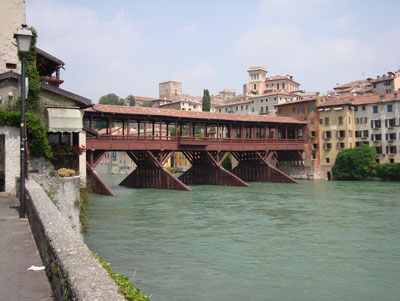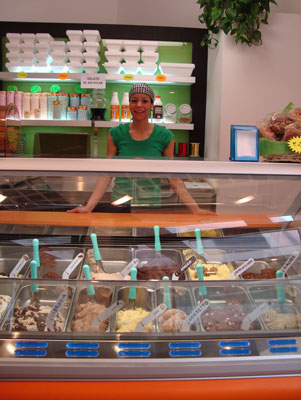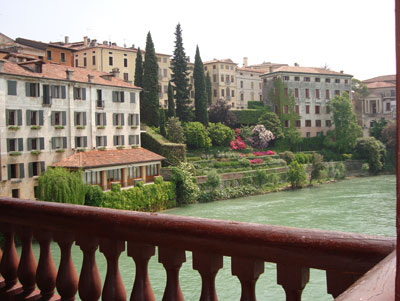Vicenza, Marostica & Bassano del Grappa
In northern Italy, the communes of Vicenza, Marostica and Bassano del Grappa are commonly touted as “very wealthy.” Well, I wouldn’t know about that part, but in early May ’09, after a week’s stay in Venice, I was certainly happy to have discovered all three.
Vicenza is known as “an inland Venice” and for its many works of the 16th-century architect Andrea Palladio.
Villa La Rotunda is considered Palladio’s finest work. (From the bus station, take the No. 8, or you can bike or even walk to it.) The design contributed to Thomas Jefferson’s Monticello. It is private, but my understanding is that there is usually one day a week when you can go inside.
According to a brochure I have (in Italian) from the tourist office at Piazza Matteotti 12, on Sunday afternoon there is a bus tour (€6, or near $8.50) that stops at La Rotunda (but just for a stop on the grounds) and also visits Villa Cordellina Lombardi for a tour inside. An all-day tour (€15) includes these plus Villa Caldogno and Villa Godi Malinverni and goes to the old part of Bassano del Grappa for a grappa tasting.
Another lovely way to visit Palladio’s stately villas is from a small boat along the Brenta Canal as my husband and I did many years ago.
With the help of a guidebook, I located most of the architect’s original buildings in the area of Corso Palladio, along with many designs finally executed by others. Don’t miss seeing his last urban work, the Teatro Olimpico, one of the oldest indoor theaters in Europe. (It’s closed Monday, as are all of Vicenza’s major sights.)
Just before the theater grounds, there is a nice bar/café called Opera (8, Piazza Matteotti) which offers pleasant outdoor seating and some of the most varied and delicious tramezzini (little filled sandwiches, usually layered) that I’d ever tasted (€1.40).
I ate there twice and ordered three different kinds — shrimp, egg and “Greek” (tomato, feta, olive and lettuce) — but most people chose the ones with ham, prosciutto, salami, etc. The bread wrapping them (like a tiny taco) was very light but didn’t become soggy with the filling.
Stepping off the Corso Palladio and into a half-moon-shaped interior mall, I discovered my gelato place for the next four days. An energetic young woman owned it, and her husband ran another one in the city. She was fun to talk to, and there was a huge selection of gelato, all very good. €2 for two scoops or €2.80 for three.
A special additional touch were two long wooden benches positioned just outside where you could sit down, FREE. In all the others, if you sit at a table to have gelato, you pay extra.
And take a look at Pasticceria Soraru on Piazza dei Signori. Behind the marble-topped pastry counters are shelves holding a vast selection of candy in old-fashioned glass jars. Everything just sparkles! (Closed Wednesday.)
Vicenza is the largest of the three towns I visited and is a good base for exploring the area. I stayed at the three-star Hotel Continental (Via G.G. Trissino, 89, Vicenza, Italy; phone +39 0444 505476, fax 513319, www.continental-hotel.it). It was a €7 taxi ride from the train station and had a parking area.
I must add that it is located across from the stadium, but nothing was scheduled during the four nights I was there, so all was quiet at night.
You will never find a better price there for what this hotel offers. I paid €52 ($75), including taxes, for a super-clean single (mine was a 12'x15' double; I was lucky) with a nice closet, exceptionally modern and well-functioning conveniences, huge opening windows (even in the bathroom) and a breakfast buffet. The staff was friendly.
From there it was an easy 20-minute walk into the city center. Ask them about the “shortcut” across a small bridge nearby, then along a tree-lined stream.
Bassano del Grappa, known for its ceramics and, of course, grappa, is smaller and elegant, situated on the magnificent, wide, gray-green rushing Brenta River over which spans a picturesque covered wooden bridge (bikes and pedestrians only).
The symbol of the town, Ponte degli Alpini, or “Ponte Vecchio” (Old Bridge), is very important to the people of Bassano. It was destroyed several times during flooding or wars but always faithfully rebuilt to the original design by Palladio in 1569.
The grand homes along its banks are in the typical Italian pastel colors. Except for restaurants, nothing was open during the time I was there, between 1 and 3:30 p.m., so my stroll was uneventful. But everything I saw made me want to go back.
And Marostica. Ahhh, Marostica. I had never even heard of it before. Helping to solve this problem, there is now an event that is held usually on evenings in September every other (even) year. In Italian, it is called Partita a Scacchi.
On a huge marble “chess board” in the middle of the grand piazza, with Renaissance-costumed townspeople and beautiful horses as the “pieces,” there is a re-creation of the match played by two noblemen over 500 years ago for the honor of a fair maiden’s hand in marriage. From the postcards I saw, the torch-lit evening setting looks spectacular.
The “town” itself consists of the three porticoed areas around the square and on one end the “new” (14th-century) castle. The ruins of the old fortress and walls sit atop a wooded hill facing it.
On a steep winding path made from hand-laid rocks, I hiked up to the top, meeting only one couple coming down and one woman going up. To my surprise, I found an inviting, modern, tile-roofed restaurant tucked neatly into one part of the fortress walls, and there was a narrow paved road on the opposite side of the hill leading up to it. Except for a man setting up umbrellas on the patio, I saw no one.
Asparagus was in season and therefore included on menus everywhere. Before I left Marostica, seated al fresco at Caffe Centrale (Piazza Castello 43) I had a huge bowl of asparagus risotto — a bit dry, in my opinion, but only €6.50 (plus water, €1.30, and service, €1.30). It was the only bar/café I saw in the square.
Marostica is approximately 17 miles/30 kilometers north of Vicenza and 4½ miles/seven kilometers west of Bassano. There is frequent bus service to the latter two towns from the “blue bus” building located separately and to the left as you exit Vicenza’s train station.
I paid €7.80 for my ticket, Vicenza-Marostica-Bassano-Marostica-Vicenza. Traveling from Venice, take the train to Bassano, then a bus to Marostica.
MARILYN HILL
Seattle, WA



